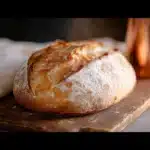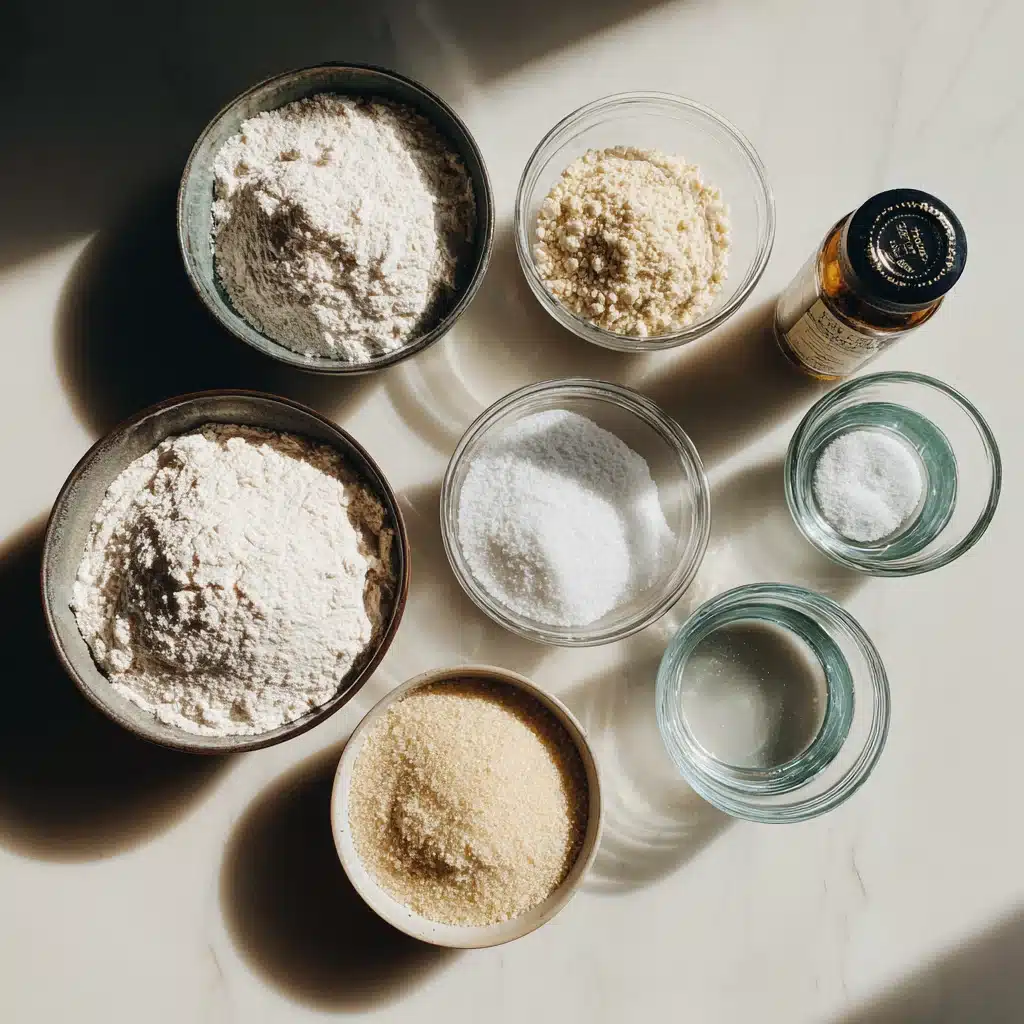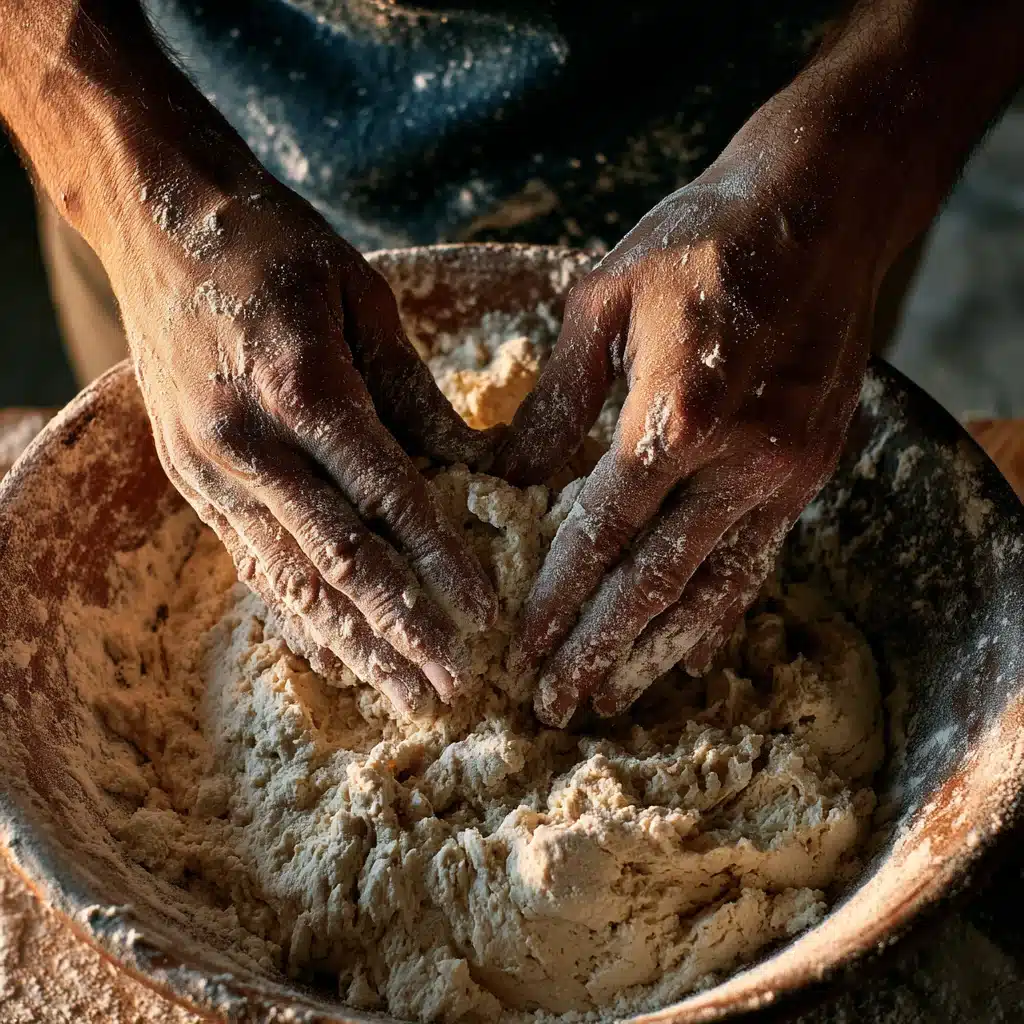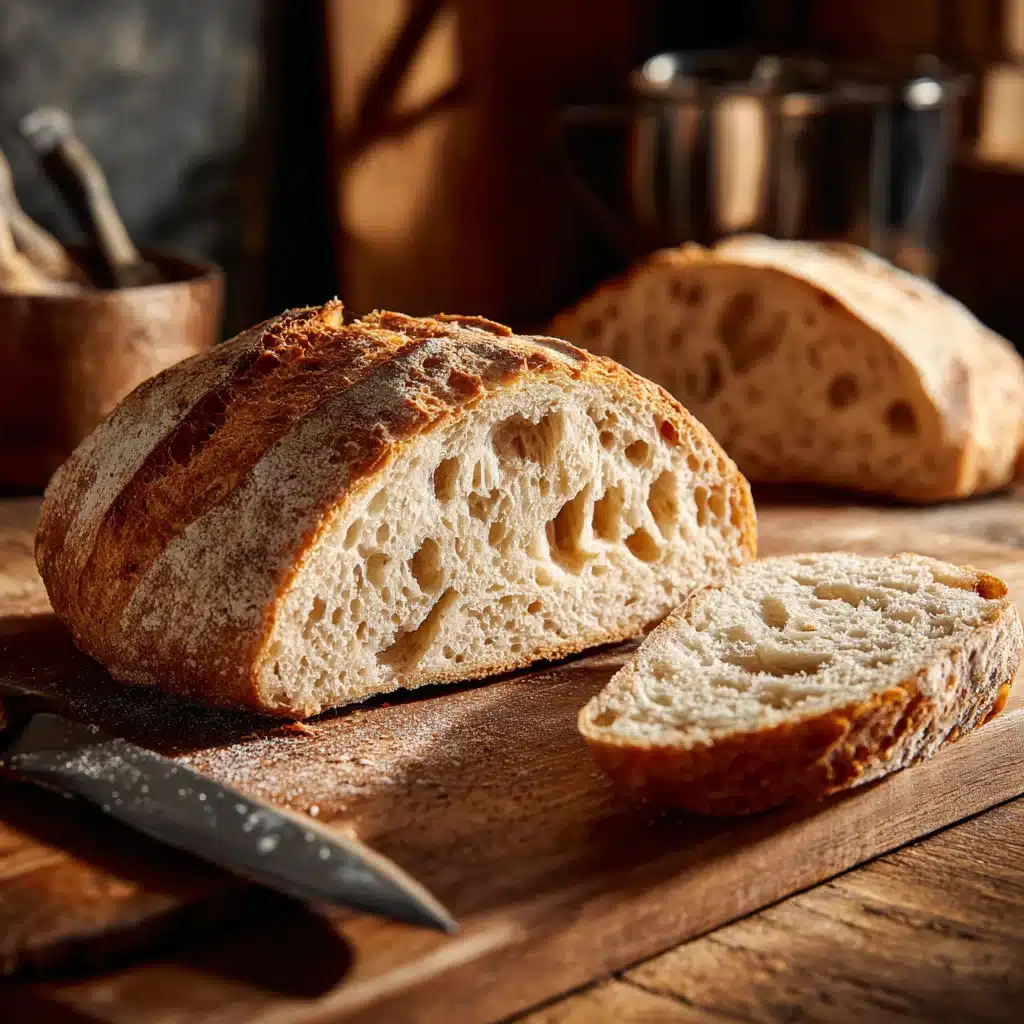Sourdough Bread Recipe for Beginners: My First Crusty Love
There’s something magical about that first loaf, the scent of fermentation, the crackling crust, the chewy crumb. In this article, I’ll walk you through my most reliable sourdough bread recipe for beginners, step by step. You’ll learn how to make sourdough bread, maintain a strong starter, avoid common beginner mistakes, and bake a loaf that makes your kitchen smell like an artisan bakery. I’ve included tips on ingredients, hydration, and fermentation timing that even seasoned bakers revisit. Whether you’re mixing your very first dough or finally aiming for that perfect ear, you’re in the right place. Let’s get started.
Sourdough Bread Recipe for Beginners
From Failed Boules to Beautiful Bread: My Beginner Story
I still remember the first sourdough bread I ever baked. It was supposed to impress a date, homemade, rustic, romantic. What came out was a pale, hockey-puck-like blob. The crust was tough, the inside gummy. Needless to say, the date was a flop, but something about the process hooked me. That floured countertop, the living scent of wild yeast, it felt ancient, intimate, and real.
If you’re looking for a sourdough bread recipe for beginners, trust me: you’re not alone in starting where I did. I’ve taught this beginner loaf in dozens of workshops across the country. It’s simple, forgiving, and doesn’t require fancy tools. What it does need is time and your patience.
The goal isn’t perfection; it’s connection. With this recipe, you’ll learn the fundamentals, how to stretch and fold, why hydration matters, how to judge fermentation by feel. You’ll begin with just flour, water, salt, and starter, ingredients you likely have right now. You’ll end up with a loaf that sings when you slice it.
And if you’re nervous about your starter, don’t worry, I’ve got a full guide on how to fix a bad sourdough starter, and you can explore moldy sourdough starter fixes here too.
Let this be the beginning of something nourishing. Whether you’re baking for comfort, curiosity, or that beautiful sour tang, this recipe is your first true crusty companion.
Print
Sourdough Bread Recipe for Beginners – 5-Step Stunning Guide
- Total Time: 16 hours (includes bulk ferment + cold proof)
- Yield: 1 loaf 1x
- Diet: Vegetarian
Description
This sourdough bread recipe for beginners walks you step-by-step through mixing, folding, proofing, and baking a crusty artisan loaf at home. With just four ingredients, flour, water, salt, and starter, you’ll master the fundamentals of wild fermentation and create a golden, chewy loaf every time. No fancy tools required.
Ingredients
475 grams all-purpose flour (3½ cups)
100 grams active sourdough starter (½ cup)
325 grams water (1⅓ cups)
10 grams salt (2 tsp)
Instructions
Mix flour, water, and starter in a large bowl until no dry bits remain. Cover and let rest for 30 minutes (autolyse).
Add salt and mix by pinching and folding the dough until well incorporated.
Over the next 3 hours, perform a stretch-and-fold every 30–45 minutes (4–5 total rounds).
Let the dough ferment at room temperature until it has risen about 50% in volume (4–6 hours).
Turn the dough out, gently shape into a round, and bench rest for 30 minutes uncovered.
Final shape the dough, place seam-side up in a floured banneton or bowl, cover, and refrigerate 12–18 hours.
Preheat oven to 475°F with Dutch oven inside. Flip dough onto parchment, score the top.
Bake covered for 20 minutes, then uncovered for 25–30 minutes until deep golden brown.
Let cool completely before slicing.
Notes
For best results, use filtered water and unbleached all-purpose flour.
Dough is sticky—avoid adding flour. Wet your hands instead.
Cold proofing improves flavor and makes dough easier to score.
If your starter isn’t active, feed it and wait until bubbly before using.
For troubleshooting starter issues, check out our discard and mold guides.
- Prep Time: 20 minutes
- Cook Time: 45 minutes
- Category: Bread
- Method: Baking
- Cuisine: American
Nutrition
- Serving Size: 1 slice
- Calories: 180
- Sugar: 0g
- Sodium: 320mg
- Fat: 1g
- Saturated Fat: 0g
- Unsaturated Fat: 1g
- Trans Fat: 0g
- Carbohydrates: 38g
- Fiber: 1g
- Protein: 5g
- Cholesterol: 0mg
Keywords: sourdough bread recipe for beginners, how to make sourdough bread, sourdough starter recipe, easy artisan bread, beginner sourdough
How to Make Sourdough Bread at Home

Understanding the Ingredients
Before you dive into any sourdough bread recipe for beginners, let’s talk ingredients. Great bread starts with quality choices, even when they’re simple. That’s the charm of sourdough: just flour, water, salt, and starter. But the way you use them makes all the difference.
The backbone of this sourdough bread recipe for beginners is 475 grams of all-purpose flour (3½ cups). You don’t need specialty flours at this stage. Basic all-purpose flour offers the right balance of protein for a dough that’s easy to work and still develops a solid crust.
Next up, 100 grams of sourdough starter, your living yeast culture. It should be active, bubbly, and smell tangy. Think of it as the heart of this recipe. If you’re unsure whether your starter is ready, check our guide on how to fix a bad sourdough starter. This is essential knowledge for anyone trying a sourdough bread recipe for beginners.
Then comes the 325 grams of water (1⅓ cups). Hydration is crucial in sourdough. It allows gluten to develop naturally, without kneading. It’s what helps form that chewy, airy interior. If you want to see how hydration changes structure, the sourdough focaccia on the site is a great high-moisture variation.
Finally, 10 grams of salt (2 teaspoons). Salt enhances flavor and regulates fermentation. It might be the smallest ingredient in this sourdough bread recipe for beginners, but it plays a huge role in texture and taste.
Here’s a quick reference:| Ingredient | Weight | Volume |
|---|---|---|
| All-Purpose Flour | 475g | 3½ cups |
| Active Sourdough Starter | 100g | ½ cup |
| Water | 325g | 1⅓ cups |
| Salt | 10g | 2 tsp |
Sourdough Starter: The Lifeline of Great Bread
For anyone starting a sourdough bread recipe for beginners, a healthy starter is essential. The 1:1:1 rule, equal parts flour, water, and starter, is a foolproof feeding method. Feed regularly, keep it warm (70–75°F), and store it loosely covered.
The most common issue? Inconsistency. Beginners often underfeed or store it too cold, too soon. If your starter smells funky or grows mold, use this moldy sourdough starter guide to get back on track.
The starter is where flavor starts. Treat it right, and every bake from this sourdough bread recipe for beginners will improve.
Beginner-Friendly Sourdough Bread Method
Mixing, Folding & Bulk Fermentation
Once your ingredients are measured and your starter is active, it’s time to make magic happen. This part of the sourdough bread recipe for beginners is where dough becomes alive. The process may seem long, but it’s mostly hands-off, and incredibly rewarding.
Step 1: Mix the Dough
In a large bowl, combine the 475g flour, 100g starter, and 325g water. Stir until no dry bits remain. The dough will look shaggy, don’t panic. Let it rest for 30 minutes. This resting stage is called autolyse, and it allows the flour to fully hydrate, making the dough easier to work with.
After the rest, add 10g salt. Wet your fingers and mix by pinching and folding until the salt is incorporated. You’re not kneading, just encouraging everything to bond.
Step 2: Stretch & Fold
Over the next 3 hours, perform a series of gentle stretch-and-folds every 30–45 minutes. Grab one side of the dough, stretch it upward, and fold it over itself. Rotate the bowl and repeat on all sides.
This technique replaces kneading in most sourdough bread recipes for beginners, building gluten structure while keeping the dough airy. You’ll notice it becoming smoother, puffier, and more elastic.
Need help knowing if your dough is ready? Gently shake the bowl. If the dough jiggles slightly and has risen by about 50%, you’re ready to move on.
Step 3: Bulk Fermentation
Cover the bowl with a damp towel and let it sit at room temperature (ideally 70–75°F) until it’s grown in size, about 4 to 6 hours. In warmer kitchens, this could be faster. In cooler ones, it might take longer.
If you’re ever unsure, you can refer to how hydration and temperature affect dough growth in our sourdough health benefits guide, which explains how wild fermentation changes both taste and digestion.
During this stage, you’re building flavor, strength, and volume. This is why a proper bulk ferment is essential to any sourdough bread recipe for beginners.
Tips for Beginners:
- Avoid over-proofing, if your dough is overly bubbly and collapses easily, you’ve gone too far.
- Watch the dough, not the clock. Dough tells you when it’s ready.
Want more beginner guidance? Explore the Clever Carrot sourdough method, a trusted source I often recommend in workshops.
This phase ends with dough that’s soft, airy, and just a little tacky. You’re ready to shape.

Shaping, Proofing & Baking the Loaf
Shaping the Dough Like a Pro
Now that your dough has fermented and doubled, it’s time to shape. This is where many beginners hesitate, but don’t overthink it, this sourdough bread recipe for beginners is meant to be approachable.
Gently tip the dough onto a lightly floured surface. Try not to deflate it. Use a bench scraper or your hands to gently shape it into a round by tucking the edges underneath, turning it a few times to create surface tension. This outer tension is key, it helps the dough hold its shape in the oven.
Let it rest for 20–30 minutes uncovered. This allows the gluten to relax before the final shaping.
For the final shape, flip the dough upside down, gently stretch it into a rectangle, fold it like a letter, and roll it into a tight round or oval. Place it seam-side up in a floured banneton or a towel-lined bowl. This step is crucial for developing structure.
Final Proof & Cold Ferment
Cover your dough and refrigerate it for 12–18 hours. This cold fermentation is what gives great sourdough its complex flavor. And it also helps you fit bread-making into a busy schedule, win-win!
The next morning, your dough will be firm and ready to bake straight from the fridge, no warming needed. If you’re wondering how cold proofing affects digestibility, check out the sourdough bread and cancer article, which explains the benefits of long fermentation.
Baking: Steam and Sizzle
Preheat your oven to 475°F with a Dutch oven inside. When the oven is hot, flip your dough onto parchment paper. Score the top with a sharp blade, a deep slash across the top will allow the bread to expand beautifully. This is where your loaf gets its signature ear.
Carefully place the dough into the Dutch oven, cover it, and bake for 20 minutes. Then remove the lid and bake for another 25–30 minutes until deep golden brown.
When done, remove it and let it cool completely on a rack. I know it’s hard, but cutting too early lets steam escape, ruining the crumb.
Celebrating Your First Loaf
Congratulations, you’ve just completed a full sourdough bread recipe for beginners, and your kitchen smells amazing. Want to get creative next time? Try adding roasted garlic like in our garlic sourdough toast recipe, or fold in some herbs, olives, or cheese.
Sourdough isn’t just food. It’s comfort. It’s science. It’s heritage. And now, it’s yours.

Conclusion: From First Loaf to Lifelong Obsession
You’ve just taken your first delicious step into the world of sourdough. From creating your own starter to folding, shaping, and baking that crusty masterpiece, you now have the tools, and confidence, to repeat it anytime. This sourdough bread recipe for beginners doesn’t just feed your body, it feeds your creativity.
The ocean fog still rolls in here in Mendocino as I pull another loaf from the oven, just like the first one I baked years ago. It’s never been about perfection. It’s about connection,with your hands, your home, and the quiet, living culture of sourdough.
Explore more ideas like sourdough discard recipes or learn about the deeper health benefits of sourdough. And remember, every loaf is a fresh start.
Frequently Asked Questions (FAQ)
What is the secret to making good sourdough bread?
The real secret to a successful sourdough loaf is patience and fermentation control. Allowing enough time for bulk fermentation, shaping properly, and baking with steam ensures a crispy crust and chewy crumb. In any sourdough bread recipe for beginners, learning to trust your dough, more than the clock, is essential.
What is the biggest mistake you can make with your sourdough starter?
Neglect. The most common mistake beginners make is underfeeding or leaving the starter in unstable conditions. If you refrigerate it too early or forget to feed it regularly, it becomes sluggish. A weak starter can lead to dense loaves. Our moldy sourdough starter guide helps troubleshoot early mistakes.
What is the secret to a good sourdough starter?
Feed consistently using the 1:1:1 rule and use filtered water. A warm, stable environment and clean container are crucial. If it smells fruity and bubbles steadily after feeding, you’re on track. This is foundational to every good sourdough bread recipe for beginners.
What is the 1:1:1 rule for sourdough?
It means feeding your starter equal parts by weight: 50g starter, 50g water, 50g flour. It’s the most common ratio for maintaining a balanced, active culture and is a staple part of preparing any beginner sourdough recipe.

